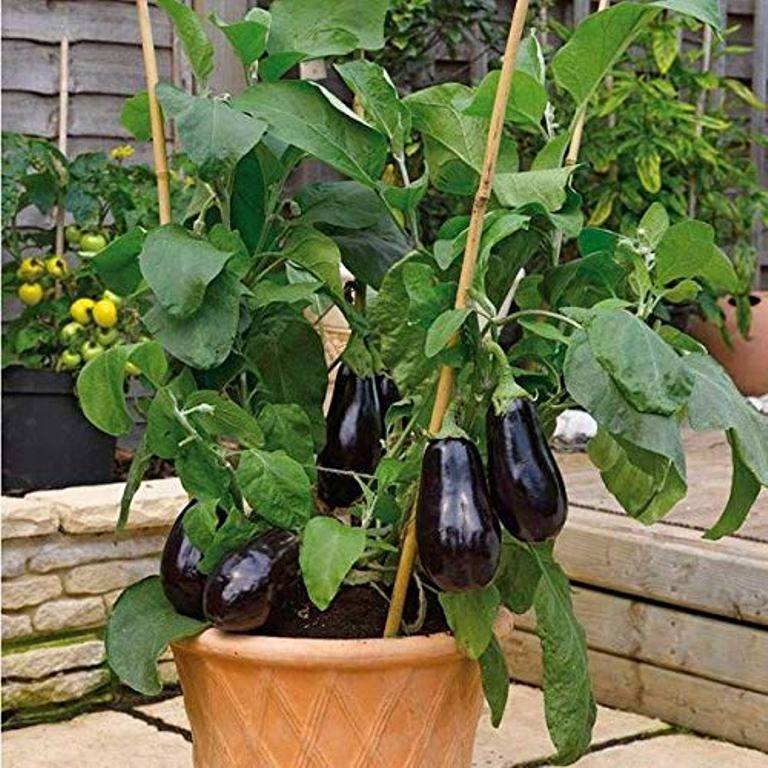
Brinjal has common Indian Names such as Baingan, Badnekai, Vankaya, Begun, Vange, Vnagi, Kattiri, Vaingan, Waangum and Vazhuthananga. Brinjal or Eggplant is a vegetable that originates in southern India, but has become a globally popular. It is a tropical perennial plant.
Indian cuisine offers many dishes based on brinjals; Baingan ka bharta and vankaya sambhar are the most popular ones. Dishes like these complete Indian Cuisine, so fresh eggplants are always welcome!
Planting Brinjal in Pot:
There are two ways you can grow Brinjal in a pot. The first is to use seeds to grow plants from scratch. Another way is to buy seedlings from a nursery. Buying seedlings is best for beginners as it makes the process easy and straightforward. You can easily find seeds or seedlings of any variety of brinjal you want to grow at nearby nurseries.
Planting Time
Usually spring is the best time to plant this vegetable in your garden; after winter has passed. But when growing in pots, you can plant all year round regardless of the season, because the plant can be moved depending on the changing weather. Brinjals can be grown in India even in winter as the climate in India is subtropical and winters are not too cold except in the Himalayan states.
Propagation of Brinjals from Seeds
In India, growing brinjals is easy because the general climate of the country is suitable for the growth. Temperature above 20 °C is ideal for its germination. You can propagate seeds in small pots to promote the germination process. Once the seeds germinate and grow to four leaves, the young trees can be transplanted into larger pots, where they can grow well.
Choosing Container Type
Be careful when choosing a pot to grow this vegetable. Since different varieties of eggplant require different size containers, larger varieties require larger pots to grow. Therefore, choose a pot that is at least 12 inches deep and has suitable drainage holes.
Requirements for Planting in Pots
You need to note the following requirements for growing brinjal in a pot-
Position
Place the plants in a place with lots of sunlight as they need a lot of heat and sunshine when they are growing. Good air circulation is also necessary for the best plant growth.
Soil Requirement
Brinjals grow best in sandy loam soils, with a neutral to slightly acidic pH. They need a soil rich in nutrients that can hold enough moisture and drain well at the same time. You can also add cow dung manure and compost to the soil to better its water retention and add nutrients.
Irrigation and Fertilization
Since this plant needs a uniformly moist soil, water it regularly every day in summer and every two or three days in winter or monsoon season. Make sure the pot has drainage holes to avoid spoiling the plants with the sticky soil. When it comes to fertilizers, brinjal plants are heavy eaters and need the right amount of fertilizer. Prepare a soil mixture with 1/4 compost and the same amount of rotten cow manure (gobar ki khaad) or chicken manure. Also add some manure during the growing season. You can also give your plants tomato fertilizer if they are not growing with organic manures.
Temperature
India has almost tropical and subtropical climates, and plants native to India adapt to the climate of the country. So you don't have to worry too much about the temperature conditions of the brinjal plants. They can easily survive and thrive in the family climate.
Plant Care
-
You can improve the yield of brinjal by pruning them. Find any yellowing leaves or worms on your plant and remove them. Also, trim tall stems as they limit plant growth.
-
Tie up your plants and give them plenty of support. Because plants can produce tall fruits, they can make plants heavier. So, tie your plant to the balcony railing, or you can tie the plant to a bamboo pole and place it in the center of the pot.
-
It is also necessary to protect plants from pests and diseases. Black fleas, bed bugs, and heartworms are common parasites in brinjal. You can easily get rid of these pests by using a homemade insecticide like neem oil or by simply applying a few drops of dish soap on them.
Harvesting
Plants typically take two to three months to mature from the date of planting. It mainly depends on the climate of the location and the variety you choose to grow.
When harvesting, just use pruning shears or a knife to cut a few inches above the lid. Harvesting is best done while cooking to keep it fresh or store in the refrigerator until you use it.
















